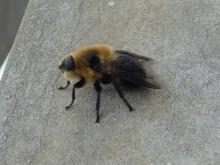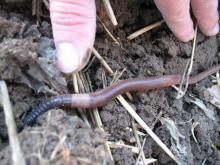Land Invertebrates
Media

Species Types
Scientific Name
About 2,000 species in North America north of Mexico
Description
Plant bugs, or mirids, are a huge family of true bugs. They are often overlooked — except by gardeners and farmers. Most mirids eat plants, and some are agricultural pests. As a group, they’re an important food source for birds and other insectivores.
Media

Species Types
Scientific Name
Scudderia furcata
Description
The fork-tailed bush katydid reaches about 1¾ inches long. It is usually leafy green and is most common in bushes, thickets, and other shrubby areas. It is most active after dusk. The call is a simple "tsip!" given every few seconds.
Media

Species Types
Scientific Name
About 40 species in North America north of Mexico
Description
Bot flies are chunky, beelike flies usually with rounded heads. Adults are not commonly seen. The larvae are short, pudgy, segmented grubs that live as parasites in the tissues of animals. Those that live just under the skin often form a bulge. Some types live in the nasal or throat cavities of deer.
Media

Species Types
Scientific Name
Pachypsylla spp.
Description
Hackberry psyllids are a genus of tiny, planthopper-like bugs. As larvae, they develop within the leaves, twigs, buds, or bark of hackberry trees. The trees form warty galls in response to their presence. In the fall, tiny adult hackberry psyllids cling to window screens.
Media

Species Types
Scientific Name
About 300 species globally
Description
True velvet mites: You’ve probably seen these small, velvety, bright red mites creeping around on rocks, plant containers, tree trunks, or on the ground, especially after a rain. Be not afraid! They are harmless — to people.
Media

Species Types
Scientific Name
Stizus brevipennis
Description
The eastern stizus is a large, solitary wasp that is often misidentified as the better-known eastern cicada-killer wasp. The markings are slightly different, however, and the eastern stizus female hunts katydids, not cicadas.
Media

Species Types
Scientific Name
Amynthas and Metaphire spp.
Description
Jumping worms are invasive earthworms that are native to east Asia. They are spreading in North America and cause problems for plants and soils. They thrash violently when disturbed.
Media

Species Types
Scientific Name
About 1,300 species in North America north of Mexico
Description
The longlegged flies are a large, diverse fly family. They often have eye-catching metallic green, copper, bronze, or blue bodies and long legs. Their delicate wings are often clear and look iridescent in bright light, but many species have dark marks near the wing tips.
Media
Species Types
Scientific Name
About 11 species in North America north of Mexico
Description
Mantidflies look like a cross between a lacewing insect and a praying mantis. They are small, delicate creatures with intricately veined wings, but the front half looks like a mantid, complete with raptorial forelegs.
Media

Species Types
Scientific Name
More than 40 species in 3 genera in North America north of Mexico
Description
Ebony bugs are definitely true bugs, but they look a lot like tiny, shiny black beetles. Their bodies are fat ovals. They’re almost always seen on flower clusters and immature seeds, often on members of the carrot or parsley family.
See Also



Media

Species Types
Scientific Name
Cisseps fulvicollis
Description
The yellow-collared scape moth is more often “orange-collared.” And whether you think it looks more like a firefly or a wasp, it’s still a moth!
Media

Species Types
Scientific Name
Nearly 150 species in North America north of Mexico
Description
Slim, delicate plume moths are instantly recognizable by their T-shaped silhouette, long legs, and muted shades of tan and brown. It can be hard to separate the various species.
Media

Species Types
Scientific Name
Pyrrharctia isabella
Description
Not many people know the adult Isabella tiger moth when they see one, but we’re all acquainted with its caterpillar, the woolly worm, or woolly bear.
About Land Invertebrates in Missouri
Invertebrates are animals without backbones, including earthworms, slugs, snails, and arthropods. Arthropods—invertebrates with “jointed legs” — are a group of invertebrates that includes crayfish, shrimp, millipedes, centipedes, mites, spiders, and insects. There may be as many as 10 million species of insects alive on earth today, and they probably constitute more than 90 percent all animal species.





















